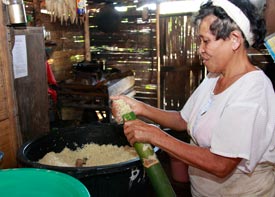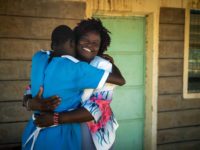Every year from June until September, the people in Minahasa, North Sulawesi, Indonesia, have celebrated a traditional thanksgiving holiday from generation to generation, called Pengucapan. It is the way the people of Minahasa express their gratitude to God for the blessings of the previous year.
The Pengucapan tradition started when the people in this remote area of Indonesia still worshiped gods. They expressed their gratitude to the ultimate god or the highest god, known as opo wanatas empung walian empung rengan-rengan.
After the harvest, Minahasa people held a kuman kan weru ceremony to eat their harvest for the first time and express their gratitude though song and praise to their gods for fertility, good weather, harvest and health. They would bring their crops as an offering to their gods.
Christianity came to Minahasa in the 1800s, and Minahasa now has one of the highest rates of Christianity in all of Indonesia.
Pastor Philep, who works with a Compassion child development center in Wiaulapi, explained that after Christianity’s arrival, the Church rejected all forms of worshiping gods as part of animism. But the Church at that time saw the expression of gratitude that Minahasa people had in this tradition and allowed them to continue it through churches.
With the presence of the Church, the form of kuman kan weru changed. The celebrations usually had been conducted in the farmland, but they were moved to the church and renamed Pengucapan, or Thanksgiving.
Now people bring cash rather than their crops to the church as their offering, as farmland decreases and people leave agriculture for business.
In Wiaulapi, a village in the southern part of Minahasa, many people are turning from farming to production of saguer, a traditional beverage made from the liquid of the palm tree.
Yance, father of a Compassion-registered child, Immanuel, became a saguer producer about three or four years ago. He had been a farmer. In Pengucapan, he now always gives cash.
Each individual area sets a different date for the actual holiday. This year, the holiday in Wiaulapi was in July.
One week before Pengucapan, the head of community announces that each family needs to clean up their house and the street in front their house. The men and the children go out together with brooms, shears and shovels and clean the main street and its ditches.
Then, every day the week before Pengucapan, each family cleans their house. They clean the windows and benches, cut the grass and wash the curtains so they are ready to welcome their guests.
For Pengucapan, people prepare special meals and welcome everyone to their house, even strangers. The food preparation starts the day before.
In the early morning, people are busy preparing the meals for their coming guests. Like other mothers in her village, Immanuel’s mother makes nasi jaha, one of the traditional meals. People usually make hundreds of nasi jaha for Pengucapan.
Nasi jaha means rice with ginger. It’s made from sticky rice mixed with coconut milk, other spices and of course ginger.
 To cook it, people put the dough into bamboo stalks covered with banana leaves. Before they bake it, they leave it to dry in the sun for a while in the bamboo. Then they put the bamboo in the fireplace.
To cook it, people put the dough into bamboo stalks covered with banana leaves. Before they bake it, they leave it to dry in the sun for a while in the bamboo. Then they put the bamboo in the fireplace.
The responsibility for preparing Pengucapan is not only given to mothers and woman, but to men as well.
The men gather and clean bamboo and cover it with banana leaves, so it will be ready to use.
At Pengucapan, other traditional food will be served such as cookies, dodol (cake made from sticky rice and palm sugar wrapped with corn leaf), fish dishes, vegetables and meat.
In some places people also serve bats and rats. They hunt bats and rats in the forest for several days before Pengucapan. The people in Minahasa only eat rats with white tails that live in the forest.
On Pengucapan day, everyone goes to the church. They gather in the church to sing and praise God for His blessing, protection and grace from the previous year. And they bring their offerings to express their gratitude.
Some people from other areas also join the service as guests. Everyone welcomes and greets all guests. Joy and gratitude fill the air.
On Pengucapan day, people and vehicles fill the road and create traffic jams, which happens very rarely in Minahasa. The government makes a schedule for every area to hold Pengucapan so they can manage the traffic jams and people easier.
Back at their houses, each family gathers, prays and reads the Scripture before they eat. They kindly greet guests and let them eat in their house to join the happiness of experiencing God’s grace.
Immanuel’s mother prepares the stalk of nasi jaha for each of her guests to take home. On that day, guests keep coming until midnight. After visiting, people take whatever food they like back to their homes.
Immanuel enjoys celebrating Pengucapan, too. His favorite part is helping his parents prepare for the day, searching for bamboo in the forest, and helping his mom clean it.
Though the form of kuman kan weru has changed, the essence is still the same. Singing and praising will still be lifted up year after year in Minahasa to opo wanatas empung walian empung rengan-rengan, Jesus Christ the Son of God.







5 Comments |Add a comment
Something I’d never have known! I don’t know about the rats and bats, but I hope that our sponsored child, Y., eats safely! Happy Pengucapan, Y. and all!
Nasi jaha sounds yummy. I love ginger!!
off i go to google it. . .
Wow, I can’t even imagine the difference in the biggest nearby city (to me) if every person would go out and clean up the outside of their homes/businesses!!! Even once a year… I will never understand litter. 🙁
I’d love to try Nasi jaha. It sounds delightful. What a wonderful celebration of God’s love. 🙂
I LOVE the idea of inviting guests into the home and sharing meals…what a wonderful community connection! True gratitude 🙂
Wow, a lot of planning goes into this!